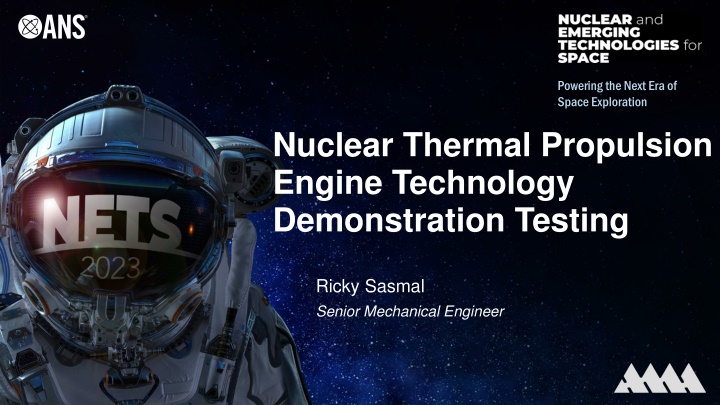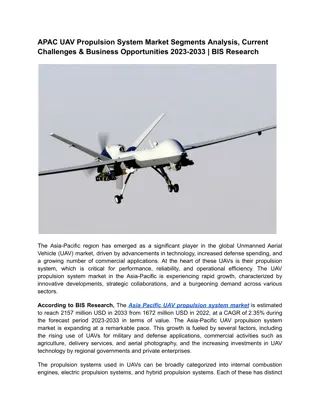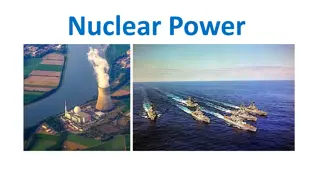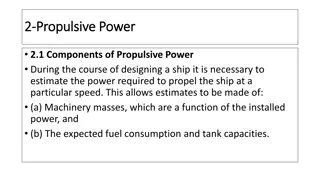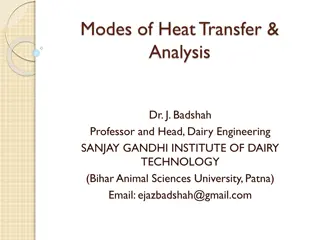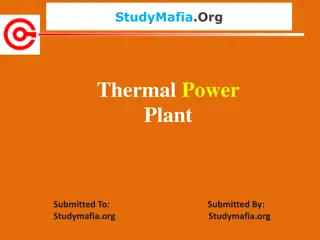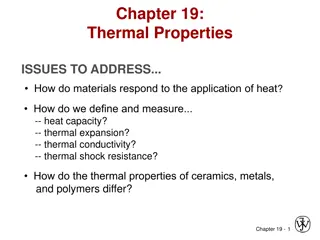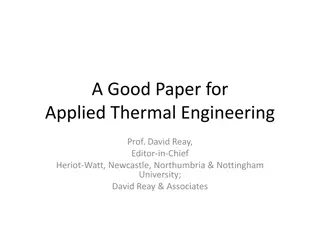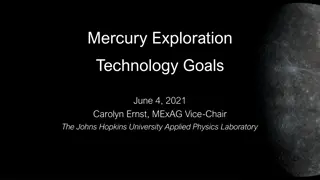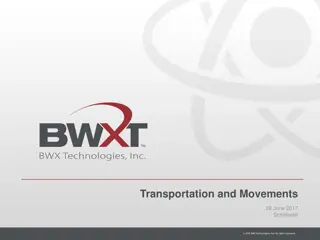Advancing Space Exploration Through Nuclear Thermal Propulsion Engine Technology
The article discusses the development, testing, and challenges of Nuclear Thermal Propulsion (NTP) engines for space exploration. It covers the history, components, and benefits of NTP engines, as well as the specific engineering considerations and advancements in this field. The content emphasizes the importance of NTP engines in powering the next era of space exploration and highlights the support provided by NASA's Space Technology Mission Directorate (STMD) for the project.
Download Presentation

Please find below an Image/Link to download the presentation.
The content on the website is provided AS IS for your information and personal use only. It may not be sold, licensed, or shared on other websites without obtaining consent from the author.If you encounter any issues during the download, it is possible that the publisher has removed the file from their server.
You are allowed to download the files provided on this website for personal or commercial use, subject to the condition that they are used lawfully. All files are the property of their respective owners.
The content on the website is provided AS IS for your information and personal use only. It may not be sold, licensed, or shared on other websites without obtaining consent from the author.
E N D
Presentation Transcript
Powering the Next Era of Space Exploration Nuclear Thermal Propulsion Engine Technology Demonstration Testing Ricky Sasmal Senior Mechanical Engineer
Acknowledgements This work was supported by NASA s Space Technology Mission Directorate (STMD) through the Space Nuclear Propulsion (SNP) Project Contract No. 80LARC17C0003 Task No. 10.020.000 Nuclear and Emerging Technologies for Space (NETS) Conference 2023 2
Agenda Nuclear Thermal Propulsion Engine Introduction Background/History High-pressure Exhaust Capture System (HECS) Description Engine Test Article HECS CONOPS Exhaust Gas Processing Conclusion Nuclear and Emerging Technologies for Space (NETS) Conference 2023 3
Nuclear Thermal Propulsion (NTP) Engine Intro Base of LH2 Tank Helium Pressurization Bottles Structural Supports Housing for Turbopumps Control Drum Actuators Radiation Shield Turbopump Exhaust (Attitude Control) Propellant heated directly by a nuclear reactor and thermally expanded/accelerated through a nozzle Specific Impulse improvement over chemical rockets due to lower molecular weight of propellant Challenges Regulatory approval Exhaust gas may contain fission products - Requires capture or processing of exhaust gas - Exhaust system design to accommodate extreme temperatures, high flow rates, and velocities Nuclear/Hydrogen hazards Reactor Reflector Control Drum Reactor Core Pressure Shell Propellant Feed Line Propellant Bleed to Turbopump Nozzle Nozzle Extension
History/Background Rover/NERVA Kiwi A Test Fire Kiwi B Cold Flow Test XE Experimental Engine Phoebus 1 NERVA NTP Engine Prototype ETS-1 Phoebus 2 Hot Fire Test 5 Nuclear and Emerging Technologies for Space (NETS) Conference 2023
History/Background Nuclear Furnace (NF-1) NF-1 developed at the end of Rover/NERVA Pre-regulatory environment - ~4 years design and development - ~$165M ($FY20) including design, fab, testing NF-1 provided first successful demonstration of exhaust processing scrubbing exhaust of radionuclides - Only Rover/NERVA reactor test with filtered exhaust before burning hydrogen in flare stack and operated successfully Included slots for 49 core elements - Composite fuel achieved better corrosion performance, while carbide fuel had cracked extensively near center of reactor 4 tests performed at full power (44MW) Exit gas temperature above 4000R for 121 minutes and above 4400R for 109 minutes total Nuclear Furnace Testing Cancelled in July 1972 when Rover/NERVA ended Nuclear and Emerging Technologies for Space (NETS) Conference 2023 6
History/Background Subsurface Active Filtration of Exhaust (SAFE) Engine Containment Chamber Radiation Shielding Also known as the borehole concept NTP Engine Exhaust gas potentially containing fission products absorbed by the ground Water Injectate Surface Casing Simple and affordable GH2 + Steam Regulatory approval challenges Soil permeability Ground Absorption Water table contamination concerns SAFE Concept Hydrogen rising Water Pumped to Surface for Post- Test Processing Liner Nuclear and Emerging Technologies for Space (NETS) Conference 2023 7
History/Background Rocket Exhaust Capture System (RECS) Engine hydrogen exhaust is burned at high temperatures with oxygen and produces steam to be cooled, condensed, and collected for controlled processing and disposal Total capture of exhaust gas Risk around the combustion process of oxygen and hydrogen to produce steam Limited by capture volume (Dewar) High cost and requires a subscale demonstration of facility Nuclear and Emerging Technologies for Space (NETS) Conference 2023 8
History/Background Real Time Processing System LH2 Engine hydrogen exhaust is injected with water to break down, evaporate, condense and cool. Noble gases removed via cryogenic cooler and hydrogen flared. Engine Containment Chamber Radiation Shielding NTP Engine Flare Developed after the NF system Cooling Water Heat Exchanger Water Sprays: Break down jet, evaporate, condense, & scrub Potential for unlimited test duration Cooling LN2 Cooling Water To Retention Pond High cost and requires a subscale demonstration of facility GH2 + Steam GH2 Demister Water Desiccant Wheel GN2 to Atmosphere Debris Trap: Catches debris and holds potentially contaminated water To Retention Pond Noble Gas Drain Nuclear and Emerging Technologies for Space (NETS) Conference 2023 9
History/Background Post Run Capture System (PRCS) Shift from certification testing to technology demonstration test Regulatory approval risk Releases exhaust gas into open air during start-up/nominal operations 20 psia internal backpressure Heavily relies on fuel integrity and ability to retain majority of fission products Designed for 12.5k lbf thrust engine test Shutdown/cooldown redirected to accumulation tanks for total capture 8:1 nozzle area ratio for engine test article 10 Nuclear and Emerging Technologies for Space (NETS) Conference 2023
HECS Introduction High-pressure Exhaust Capture System Higher internal backpressure in the system (300 psia) compresses exhaust gas volume Feature PRCS 11 ft 54 ft 8 ft HECS 6 ft 22 ft 1.5 ft Compressed volume allows for more tanks and total capture Vertical Pipe Diameter Vertical Pipe Length/Test Stand Height Header Diameter Favorable for regulatory approval Requires engine test article change Nuclear and Emerging Technologies for Space (NETS) Conference 2023 11
HECS Testing Article NTP Engine with 2:1 Nozzle Area Ratio (AR) 2:1 Nozzle Ratio for HECS 8:1 Nozzle Ratio for PRCS A smaller AR reduces the diameter at the nozzle exit and length of the overall nozzle, which improves the structural integrity, thus allowing for higher pressure loading upon the nozzle. The smaller AR also causes the exhaust gas to exit the nozzle plane at a lower velocity. Nuclear and Emerging Technologies for Space (NETS) Conference 2023 12
HECS CONOPS Prestart System is inert and purged Accumulation tanks are filled with water Tank drain valves and isolation valves closed Water spray system on and water supply valves open Drain valve at base of duct opened to control water level Nuclear and Emerging Technologies for Space (NETS) Conference 2023 13
HECS CONOPS Start-up/Nominal Operations Water spray system on and water supply valves open Drain valve at base of duct opened to control water level Start-up/nominal tanks valve open Drain valve for start-up/nominal tanks open - Controls internal backpressure Shutdown/cooldown tank valves closed and isolated Nuclear and Emerging Technologies for Space (NETS) Conference 2023 14
HECS CONOPS Shutdown Water spray system on and water supply valves open Drain valve at base of duct opened to control water level Start-up/nominal tanks full and associated valves closed Shutdown/cooldown tank isolation valves open Drain valve for shutdown/cooldown tanks open - Controls internal backpressure Nuclear and Emerging Technologies for Space (NETS) Conference 2023 15
HECS CONOPS Cooldown Water spray system on and water supply valves open Drain valve at base of duct closed to accumulate water - Creates water seal and reduces purge volume Isolation valve in header pipe closes Valve in cooldown piping opens to direct flow straight to tanks at a lower pressure Drain valve for shutdown/cooldown tanks open - Controls internal backpressure Nuclear and Emerging Technologies for Space (NETS) Conference 2023 16
HECS CONOPS Post-cooldown Water spray system off and water supply valves closed Shutdown/cooldown tanks full and valves close Drain valves close Purge on, evacuating exhaust gas from main vertical pipe Nuclear and Emerging Technologies for Space (NETS) Conference 2023 17
Exhaust Gas Processing Processing of Cooldown Flow and Extensibility Option Processes cooldown flow with real time processing system Removes accumulation tank configuration and replaces with a full-scale real-time processing system Smaller, COTS components utilized due to much lower flow rate Utilizes existing infrastructure to reduce cost for a development/certification test Reduces number of cooldown tanks and allows for longer testing duration Nuclear and Emerging Technologies for Space (NETS) Conference 2023 18
Conclusion Ground testing provides ability for PIE of components, more data collection, ability to halt and restart testing to replace/inspect components/systems HECS provides a lower cost, shorter lead time option for a technology demonstration test of a NTP engine HECS total capture capability provides favorability for regulatory approval Technology demonstration test matures NTP engine TRL without high initial investment Maturation of TRL through technology demonstration testing reduces risk for development, certification, and/or flight testing Nuclear and Emerging Technologies for Space (NETS) Conference 2023 19
References [1] A.M. Associates, TAR Presentation, 2022 [2] H. Gerrish, M. Houts, Nuclear Thermal Propulsion, 2017 [3] A.M. Associates, NETS NTP Ground Demo Testing, 2023 [4] A.M. Associates, FY22 NTP Ground Testing Report, 2023 [5] L. Holmes, M. Neely, Ground testing Overview, 2021 <Presentation Title> Nuclear and Emerging Technologies for Space (NETS) Conference 2023 20
